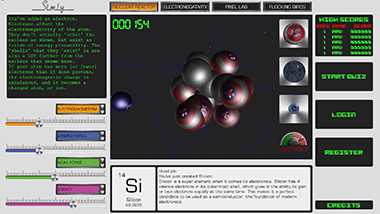
Simly is a collection of four web games that introduce high-school students to the concepts of Emergent Systems and Numerical Modelling.
Conceived as a way to let high-school students engage with concepts in science they'd typically need years of maths study to even approach, Simly aims to show that science can enthrall even students who've been blunted by years of trivial science experiments. A networked scoring system so students can challenge their friends, and a tried-and tested set of introductory activities have also been developed as part of the program, along with integrated, anonymised, total-interaction analytics.
The website and associated activity plans have since been adopted as a continuing feature of the University of Sydney Faculty of Engineering and IT's high-school outreach program, and has been used by hundreds of high-school students.
The website and associated activity plans have since been adopted as a continuing feature of the University of Sydney Faculty of Engineering and IT's high-school outreach program, and has been used by hundreds of high-school students.
Simly's 'Nuclear Reactor' game introduces students to the idea of the universe as an emergent system. With just four fundamental forces describing the ways that three subatomic particles can interact, and a whole lot of time, you can build everything around us!
http://simly.com.au/nuclear_reactor.php
http://simly.com.au/nuclear_reactor.php


The 'Electronegativity' game builds on 'Nuclear Reactor' to reinforce some concepts of chemistry and show how more complex molecules can form. Students must correlate each pair of elements' respective electronegativities with their propensity to form different kinds of bonds.
http://simly.com.au/electronegativity.php
http://simly.com.au/electronegativity.php
Simly introduces students to Numerical Modelling through Cellular Automata in the 'Pixel Lab' game. Perhaps the best-known example of Cellular Automata is British mathematician John Conway's 'Game of Life', but Stephen Wolfram has also done seminal work in this area. Simple rules determine the on/off state of each pixel in the next iteration of an animation, based on its on/off state and that of its immediate neighbour pixels in the current iteration. Students can play for points by correctly deciding whether the centre pixel in a 9-pixel grid will be on or off.
http://simly.com.au/pixel_lab.php
http://simly.com.au/pixel_lab.php

Finally, the 'Flocking Birds' game introduces students to an engineering application of all these concepts. Based on Craig Reynolds' 'Boids' simulations, this game allows students to individually control the parameters of the simulation, and watch for changes in the behaviour of the 'birds'. This game ties in with concepts of biomimicry. For example, flocking behaviour like this is now being researched for use in autonomous robot swarms.
http://simly.com.au/flocking_birds.php
http://simly.com.au/flocking_birds.php